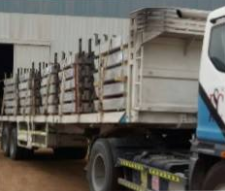Cathodic Protection of Steel Piles in Practice
- ESC Group

- Dec 12, 2017
- 3 min read
Updated: Oct 5, 2021
The most rapid development of cathodic-protection systems was made to meet the requirements of the quickly expanding oil and natural gas industry which benefits a lot from its advantages. Cathodic Protection of wharf structures is an effective method of corrosion protection.
Cathodic protection can, in principle, be applied to any metallic structure in contact with a bulk electrolyte. In practice its main use is to protect steel structures buried in soil or
immersed in water. The cathodic corrosion process is usually the reduction
of oxygen. It cannot be used to prevent atmospheric corrosion. Structures commonly protected are the exterior surfaces of pipelines, ships’ hulls, jetties, foundation piling, steel sheet-piling, and offshore platforms.
Cathodic protection has also been applied to steel embedded in concrete to copper-based alloys in water systems, and, exceptionally, to lead-sheathed cables and to aluminium alloys, where cathodic potentials have to be very carefully controlled.
Cathodic Protection increases the design life and can be replaced much more easily than reapplication of corrosion protection coatings. It is typically utilised in conjunction with corrosion coatings to form a complete corrosion protection system. It is a sacrificial form of protection where an anode, typically made of aluminium or zinc alloy is bolted or welded to the steel structure. The steel and anode material form a galvanic cell where the anode oxidizes preferentially to the steel, hence reducing or eliminating the rusting of the steel. ESC has the capability to design, supply, install and commission such cathodic protection systems.
One method cathodic protection may be achieved is by means of the sacrificial anodes systems which uses the galvanic series of metals. Sacrificial anode systems have the advantage of being simple to install, independent of any source of electric power, suitable for localised protection, less liable to cause interaction on neighbouring structures.
The current density required to maintain the protection potential is very dependent on local conditions. Increased availability of oxygen at the surface of the metal will directly increase current density. Thus, current densities to structures in sea water, rivers, etc are likely to vary continuously. The pH of the environment will also be important. The presence of coatings, marine fouling, and calcareous deposits will have a profound effect on current density.
Having decided on the appropriate current density, the total anode current can be determined from the area of the structure. The size of the anodes can then be determined taking into account the working life of the protected structure or the period required between refits.
It is difficult to over-protect the structure and moderately easy to obtain a uniform electrode potential across the structure. The most severe limitation of the sacrificial anode is the small driving force which restricts its use to conductive environments or well-coated systems. To protect a large structure, such as a pipeline, with sacrificial anodes, a large number of them would need to be distributed along it, involving a multiplicity of electrical connections and considerable installation work.
Consideration must also be given to spark hazards created by the introduction of electric
currents into structures situated in a hazardous atmosphere. Any secondary structure residing in the same electrolyte may receive and discharge the cathodic-protection direct current by acting as an alternative low-resistance path. Corrosion will be accelerated on the secondary structure at any point where current is discharge to the
electrolyte.
It is an advantage of sacrificial-anode schemes that they are not prone to creating severe interaction problems and therefore are popular for protection in congested and complex locations. Methods and procedures are available for overcoming interaction, and testing must be carried out in the presence of all interested parties, so that the choice of remedial measures may be agreed if and when the acceptable limit of interaction is exceeded.














